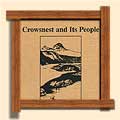 Heritage Community Foundation Presents
Heritage Community Foundation PresentsAlberta Online Encyclopedia
 |
|||
  |
|||
|
Home>> The Industry>> Mines>> Crowsnest Pass>> Leitch Collieries |
|||
| Leitch Collieries | |||
Page 1 | 2 | 3 | 4 | 5 | 6 | 7 | 8 | 9 The Story of Police Flats — Leitch Collieries Early in 1892 William headed further west, this time with a team of oxen and a wagon loaded with necessary pioneer equipment. He located and staked out a homestead near the present town of Alameda. He built a sod shack and set about breaking land. In the fall he drove the team of oxen some forty miles to where coal was being dug out of the side of a valley and obtained fuel for the winter. At this time William resolved the dream he had had as a boy of becoming a miner must be made a reality. When farm work was finished in the fall William would go back to the mine and Isaac Cockburn would give him a job for the winter. William qualified to become pit boss at the mine, then manager, he became first a shareholder and finally owner of the mine. The community of Coalfields grew up around the Hamilton mine. I In 1905 the mines were sold and Hamilton moved his family to Medicine Hat. Immediately, Jack and Bill Kerr who went with him, set out with a team and prairie schooner to check riverbanks and ravines for coal outcroppings. Men like this had to have a sixth sense for locating coal, oil or other minerals, for they had virtually no technical equipment. After locating several prospective locations, at least one of which was later worked, and after covering wide areas of the western prairie, Hamilton opened a mine on flat, undeveloped prairie, where Taber now stands. His wife and children moved out to be with him one summer, living in a tent, while the new mine went into production, increased its tonnage, prospered and was sold promptly in the summer of 1906. W. L. (Billy) Hamilton as he was known, again moved farther west to prospect for coal in the foothills. In April 1907, a third daughter, Helen, was born and the family was moved to Lethbridge. This then is the background of William Hamilton, pioneer
prospector, and entrepreneur miner; when he arrived in the
Crowsnest Pass to risk his last dollar in an area where roads
and bridges had yet to be built, and railway stations were far
apart. Telephone and other lines of communication were at their
beginnings, slow and inadequate. This article is extracted from Crowsnest and its People: Millennium Edition (Coleman, Alberta, Crowsnest Pass Historical Society, 2000. The Heritage Community Foundation and the Year of the Coal Miner Consortium would like to thank the authors and the Crowsnest Pass Historical Society for permission to reprint this material. |
|||
 |
|||
For more on coal mining in Western Canada, visit Peel’s Prairie Provinces.



